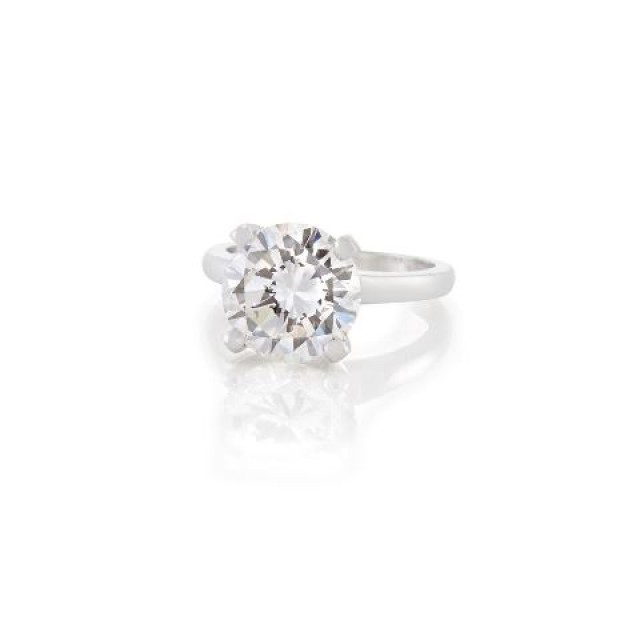How to Buy a Diamond at Auction
02/08/2017 Jewelry

If you are in the market for a new diamond ring, whether an engagement ring or simply something special, auctions are an ideal resource to consider. Doyle’s auctions offer an array of styles of different ages, metals, designers and price points. With multiple jewelry sales a year in both New York and Beverly Hills, there are many opportunities to find rings that suit any taste and budget. Doyle’s Jewelry Specialists are always happy to assist you with information on the diamonds in any of our upcoming sales. This guide is designed as a walk-through of some of the things to consider when buying a diamond at auction.
Style
Doyle’s sales always offer a wide variety of diamond ring styles, from the sophisticated geometry of Art Deco design to the delicate pavé settings popular today, and everything in between. This Art Deco setting centering an old European-cut stone blends the design and craftsmanship of the 1920s while highlighting an impressive diamond. In contrast, this classic solitaire ring exudes clean elegance set in platinum. Solitaire is a term describing a setting in which a single stone is centered and held in by three to six prongs. It is a design that is always popular, especially for engagement rings. Another classic setting is similar to a solitaire, except the center stone might be flanked by two smaller stones. This large bombé ring centering a 7.18 cts. emerald-cut diamond and accented by numerous other diamonds would be a perfect choice as a statement piece.
Minimal styles are also popular, and a bezel setting can often provide the clean lines and security appropriate for a ring of daily wear. The bezel setting, also referred to as collet-set or a rub-over setting technique, is one in which metal completely encircles any one stone. Other setting style techniques include three-stone settings, in which three stones of similar size are set in one row; pavé settings in which there may be one larger center stone, and the rest of the ring is covered in at least 3 rows of very small stones; and halo settings in which a center stone is encircled by at least one row of small stones. There are many variations on all of the styles described above, and it is important to examine the ring in person to ensure that the style is in keeping with your vision and style.
The Four C’s of Diamonds
Arguably the most important part of the diamond-buying process, as it is often the main driver of cost, are the Four Cs. They were introduced by the GIA (Gemological Institute of America) to produce a systematic protocol of measuring a diamond’s Cut, Color, Clarity and Carat Weight.
Cut
Cut describes the shape of a stone -- round brilliant, old European, old-mine, cushion, square, oval, marquise, pear, emerald, baguette, tapered baguette, and other shapes deemed ‘fancy’ because they are not as prevalent. The quality of the cut is also an important factor. A well-cut stone will appear more brilliant than one whose facets are not in proportion. The most popular cuts for engagement rings are round brilliant cuts, whose facets create the most brilliant appearance.
Color
Color is also an important consideration when buying a diamond. The GIA grades diamond color on a scale of D to Z. Stones that are D color contain no yellow in their appearance, and stones that are Z color are very yellow to the eye. Color is an key factor in establishing the value of a diamond, since it is more obvious to the eye than are an Excellent cut or Flawless clarity. There may not be much visible difference in the color of this stone and the other, but one can definitely see the difference in their selling prices.
Clarity
Another visible characteristic of a diamond refers to the proportion of inclusions present in the stone, or its clarity. Diamonds can have a wide variety of clarity characteristics, such as crystals, feathers, clouds, twinning wisps, chips, nicks, graining and others, and their density and position within the stone determines their clarity grade. Clarity grades as established by the GIA range from Flawless to Included. It is important to inspect the stone in person, as clarity grades refer to the proportion of inclusions in relation to each other, and do not describe exact inclusions in each stone. Every diamond is unique!
Carat Weight
The weight of diamonds is measured in carats. The cut of a diamond can influence the perceived carat weight of the stone, and higher carat stones will appear larger on certain hands than on others.
And Lastly...
The Four C’s are important to think about in conjunction with each other when purchasing a diamond at auction. A higher carat size might suggest a simpler setting, or an E color stone might be able to exhibit SI2 clarity if the cut is Good. The give and take of the Four C’s will help you achieve value while remaining in your budget. Doyle auctions are an excellent choice to consider, as our Important and Fine Jewelry sales offer many different diamond rings in a range of values. Our Jewelry Specialists welcome your inquiries, whether you are looking for a particular stone or if you have any questions about the diamond-buying process.